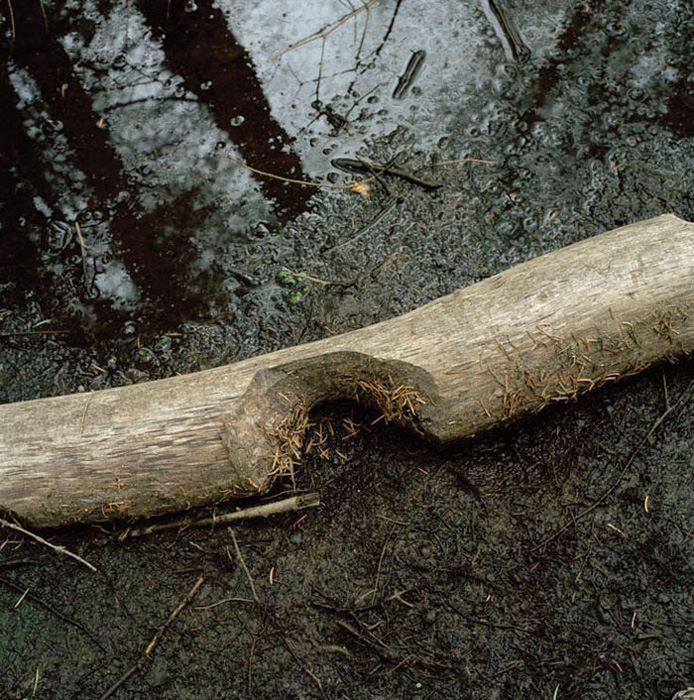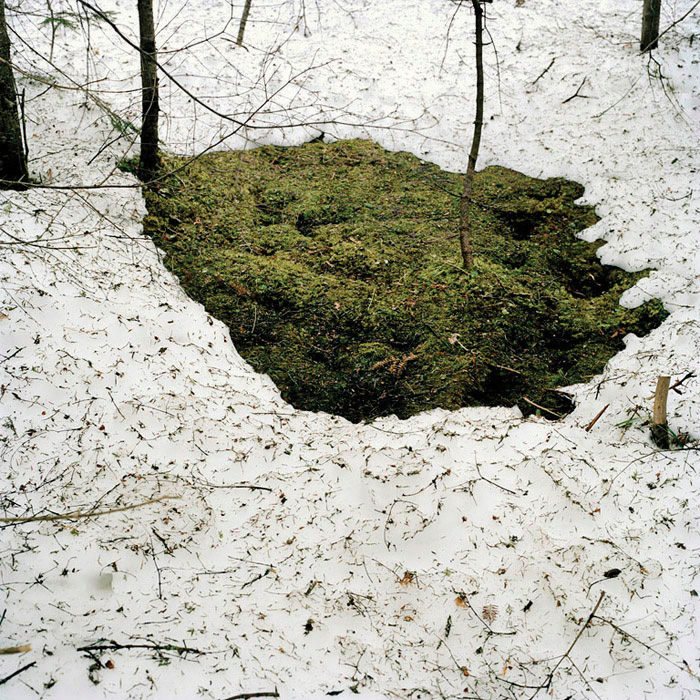[Spring/Summer]
Normand Rajotte
Like a Whisper (The Continuation)
Galerie Pangée, Montréal
14 September to November 9, 2011
Every summer until we were teenagers, my sister and I spent three entire months running like wild things through the dense forest of the Laurentians. With our two neighbour friends and a borrowed husky dog, we explored every nook, cranny, brook, and blueberry bush of a stretch of about two kilometres around our cottage all day, every day. They were some of my favourite times, times of excitement, serenity, and free-spiritedness that I’ve attempted to re-create since – with only a modicum of success. So, when photographer Normand Rajotte told me of his return to the land and his purchase, with his brothers, of a little bit of wilderness at the foot of Mont-Mégantic, in the Eastern Townships, I viscerally understood the yearning that he had satisfied. “The forest was always important in my childhood,” he told me as we walked through his recent exhibition at Galerie Pangée, “Like a Whisper (The Continuation),” which featured thirteen small- and medium-sized colour landscape prints. “It was marvellous to me, by which I mean I marvelled at it. It was a place of fantasy tinged with surrealism – I’d see things that weren’t there, perceive things that were just outside the periphery of vision.”
The body of work at Galerie Pangée was the second chapter of the “Like a Whisper” show curated by Anne-Marie Ninacs as part of Le Mois de la Photo de Montréal 2011 and concurrently exhibited at L’Arsenal, in Griffintown. Whereas for the works in that space Rajotte’s lens was focused very tightly on nature’s turf – most of them literally displayed a square metre or so of earth, soil, grass, or mud and the animal traces that they encase, which, for the artist, act as a reference to the photographic imprint – the photographs at Galerie Pangée took a greater distance from their subject. This show featured more traditional perspectives on landscape, shot with a tripod from a standpoint that allows the viewer to see ground, horizon, and sky, as well as the forest in all its thick intensity and evocative chaos. In a way, this was a departure for Rajotte; his previous two series have been much more tightly cropped and focused on abstract textures, natural formations, and markings on the ground. It was nice to see him look up. W. J. T. Mitchell is an avid examiner of landscape in art, and in his book Landscape and Power, he complexifies the notion into a more sophisticated, three-pronged idea that involves a mix of place, space, and landscape.1 Though they are three facets of a single relationship with land, these terms can be distinguished: place is the physical location; space is what that place becomes once it is put into play by human use, once it has been ascribed a purpose or significance; and landscape is what it becomes once it is encountered as an image, or a representation. Where Rajotte breaks from the Romantic tradition of landscape that champions pristine, untouched wilderness is in his acknowledgment of Mitchell’s idea of space – that activation of a place by human presence and conception. Recurrently in his oeuvre, but also in two notable works in “Like a Whisper (The Continuation)” – one in which you see the artist’s hand in a pool of water, playing with minnows, the other in which you see his footsteps in the mud, overlaid with a heron’s – Rajotte consciously includes humanity in his homage to nature. His conception is not of the wild as an unspoiled ideal or a rapidly declining natural resource; rather, it is simply the framework for our existence, a holistic component of who we are. “When I’m in nature I feel like I’m part of the ambient air,” he says. Man and Mother Nature are simply indivisible.
Since buying that land in 1997 and regaining access to a type of nature with which he hadn’t lived since childhood, Rajotte has built – with his own two hands – a small cottage and set about exploring its surroundings, camera in tow. For about a decade, he did so methodically: he would pore over the map in the evening and chart out his next day’s explorations, which could take him anywhere within a twenty-kilometre radius of the house. But as the years passed, having familiarized himself with his environs, Rajotte reduced his circle of exploration and began returning to certain spots within a couple of kilometres from his cottage over and over, year after year, month after month. “I became attuned to the transformations – because nature moves, you know, with the seasons, with light conditions, depending on the time of day,” he says. Rajotte may walk for two hours but travel only a short distance. If he feels inclined to go left, he goes left; then he may turn right, and then choose to retrace his steps. “I follow the forest’s own movements,” he says. It is as if, over the years, Rajotte has undergone a reverse walkabout.
Within Australian Aborigine cultures, the walkabout was a common rite of passage for young boys as they transitioned into manhood that involved their meandering over large and unknown territories. The idea was to walk aimlessly, often for months, guided not by logic or the conscious mind but by the pull of ancestry and spiritual guidance. I see in Rajotte’s method a parallel learning experience, in which he has sought to shed the rigours of controlled, rational behaviour – a very adult and urban method – to instead adopt an instinctive attitude to his environment. My personal hunch is that he is trying to regain a wisdom that he had unthinkingly mastered as a ten-year-old.
Either way, Mitchell was on to something when he wrote, “The indeterminacy of affect seems, in fact, to be a crucial feature
of whatever force landscape can have.”2
1 W. J. T. Mitchell, “Preface: Space, Place, and Landscape,” in Landscape and Power (Chicago and London: University of Chicago Press), pp. vii–xii.2 Ibid, p. vii.
Isa Tousignant is a contributing editor for Canadian Art magazine and a blogger on the Montreal arts scene for akimbo.ca, as well as a freelance writer on culture, lifestyle, design and travel. After working as a newspaper and magazine editor for over a decade, she recently left the land of cubicles to write her first book, about animals in contemporary art.


